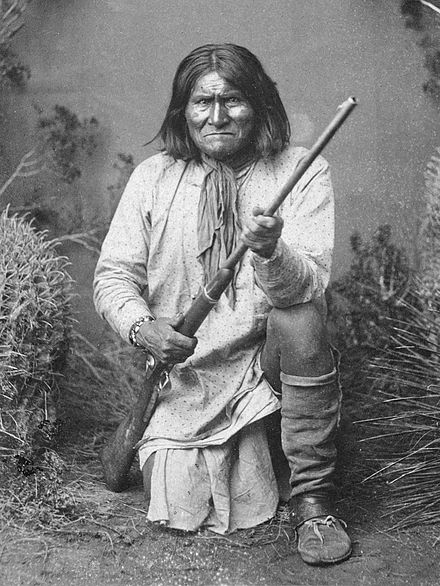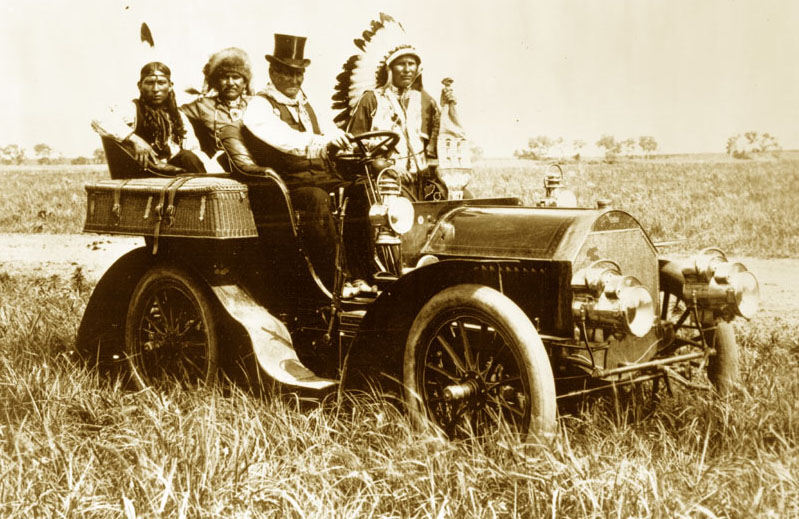Geronimo biography

Quick Facts
- NAME: Geronimo
- OCCUPATION: Warrior
- BIRTH DATE: June 1829
- DEATH DATE: February 17, 1909
- PLACE OF BIRTH: No-Doyohn Canyon, Mexico
more about Geronimo
Best Known For
Geronimo was a Bedonkohe Apache leader of the Chiricahua Apache, who led his people's defense of their homeland against the military might of the United States.Videos see all videos
-
 Geronimo - Full Episode (42:25)
Geronimo - Full Episode (42:25)
Quiz
 Think you know about Biography?
Think you know about Biography? Answer questions and see how you rank against other players.
Play Now
Print
Cite This
Synopsis
Born in June 1829, in No-Doyohn Canyon, Mexico, Geronimo
continued the tradition of the Apaches resisting white colonization of
their homeland in the Southwest, participating in raids into Sonora and
Chihuahua in Mexico. After years of war Geronimo finally surrendered to
U.S. troops in 1886. While he became a celebrity, he spent the last two
decades of his life as a prisoner of war.
Contents
Early Years
A legend of the untamed American frontier, the Apache leader Geronimo was born in June 1829 in No-Doyohn Canyon, Mexico. He was a naturally gifted hunter, who, the story goes, as a boy swallowed the heart of his first kill in order to ensure a life of success on the chase.Being on the run certainly defined Geronimo's way of life. He belonged to the smallest band within the Chiricahua tribe, the Bedonkohe. Numbering a little more than 8,000, the Apaches were surrounded by enemies—not just Mexicans, but also other tribes, including the Navajo and Comanches.
Raiding their neighbors was also a part of the Apache life. In response the Mexican government put a bounty on Apache scalps, offering as much as $25 for a child's scalp. But this did little to deter Geronimo and his people. At the age of 17 Geronimo had already led four successful raiding operations.
Around this same time Geronimo fell in love with a woman named Alope. The two married and had three children together.
Then tragedy struck. While out on a trading trip, Mexican soldiers attacked his camp. Word of the ransacking soon reached the Apache men. Quietly that night, Geronimo returned home, where he found his mother, wife and three children all dead.
Warrior Leader
The murders devastated Geronimo. In the tradition of the Apache, he set fire to his family's belongings and then, in a show of grief, headed into the wilderness to bereave the deaths. There, it's said, alone and crying, a voice came to Geronimo that promised him: "No gun will ever kill you. I will take the bullets from the guns of the Mexicans … and I will guide your arrows."Backed by this sudden knowledge of power, Geronimo rounded up a force of 200 men and hunted down the Mexican soldiers who killed his family. On it went like this for 10 years, as Geronimo exacted revenge against the Mexican government.
Beginning in the 1850s, the face of his enemy changed. Following the end of the Mexican-American War in 1848, the U.S. took over large tracts of territory from Mexico, including areas belonging to the Apache. Spurred by the discovery of gold in the Southwest, settlers and miners streamed into their lands. Naturally, tensions mounted. The Apaches stepped up their attacks, which included brutal ambushes on stagecoaches and wagon trains.
But the Chiricahua leader, Geronimo's father-in-law, Cochise, could see where the future was headed. In an act that greatly disappointed his son-in-law, the revered chief called a halt to his decade-long war with the Americans and agreed to the establishment of a reservation for his people on a prized piece of Apache property.
Geronimo proved to be as elusive as he was aggressive. However,
Contents
Out on his own again, Geronimo and a small band of Chiricahua followers eluded American troops. Over the next five years they engaged in what proved to be the last of the Indian wars against the U.S.
Perceptions of Geronimo were nearly as complex as the man himself. His followers viewed him as the last great defender of the Native American way of life. But others, including fellow Apaches, saw him as a stubborn holdout, violently driven by revenge and foolishly putting the lives of people in danger.
With his followers in tow, Geronimo shot across the Southwest. As he did, the seemingly mystical leader was transformed into a legend as newspapers closely followed the Army's pursuit of him. At one point nearly a quarter of the Army's forces—5,000 troops—were trying to hunt him down.
Finally, in the summer of 1886, he surrendered, the last Chiricahua to do so. Over the next several years Geronimo and his people were bounced around, first to a prison in Florida, then a prison camp in Alabama, and then Fort Sill in Oklahoma. In total, the group spent 27 years as prisoners of war.
Final Years
While he and the rest of the Chiricahua remained under guard, Geronimo experienced a bit of celebrity from his white former enemies. Less than a decade after he'd surrendered, crowds longed to catch a glimpse of the famous Indian warrior. In 1905 he published his autobiography, and that same year he received a private audience with President Theodore Roosevelt, unsuccessfully pressing the American leader to let his people return to Arizona.His death came four years later. While riding home in February 1909, he was thrown from his horse. He survived a night out in the cold, but when a friend found him the next day, Geronimo's health was rapidly deteriorating. He passed away six days later, with his nephew at his side.
"I should never have surrendered," Geronimo, still a prisoner of war, said on his deathbed. "I should have fought until I was the last man alive."
© 2013 A+E Networks. All rights reserved.
Geronimo - Wikipedia, the free encyclopedia ~ http://en.wikipedia.org/wiki/Geronimo ~

++++

++++
 ++++
++++++++
++++++++++++++++++++++++++++++++++
Key Profiles, Bios + Links Blog
http://key-profiles.blogspot.com/
HELP Portal ~ http://help-matrix.ning.com/ ~
Peta_de_Aztlan Blog ~ http://peta-de-aztlan.blogspot.com/ ~ @Peta_de_Aztlan
+++++++++++++++++++++++++++++++++++++++++


No comments:
Post a Comment